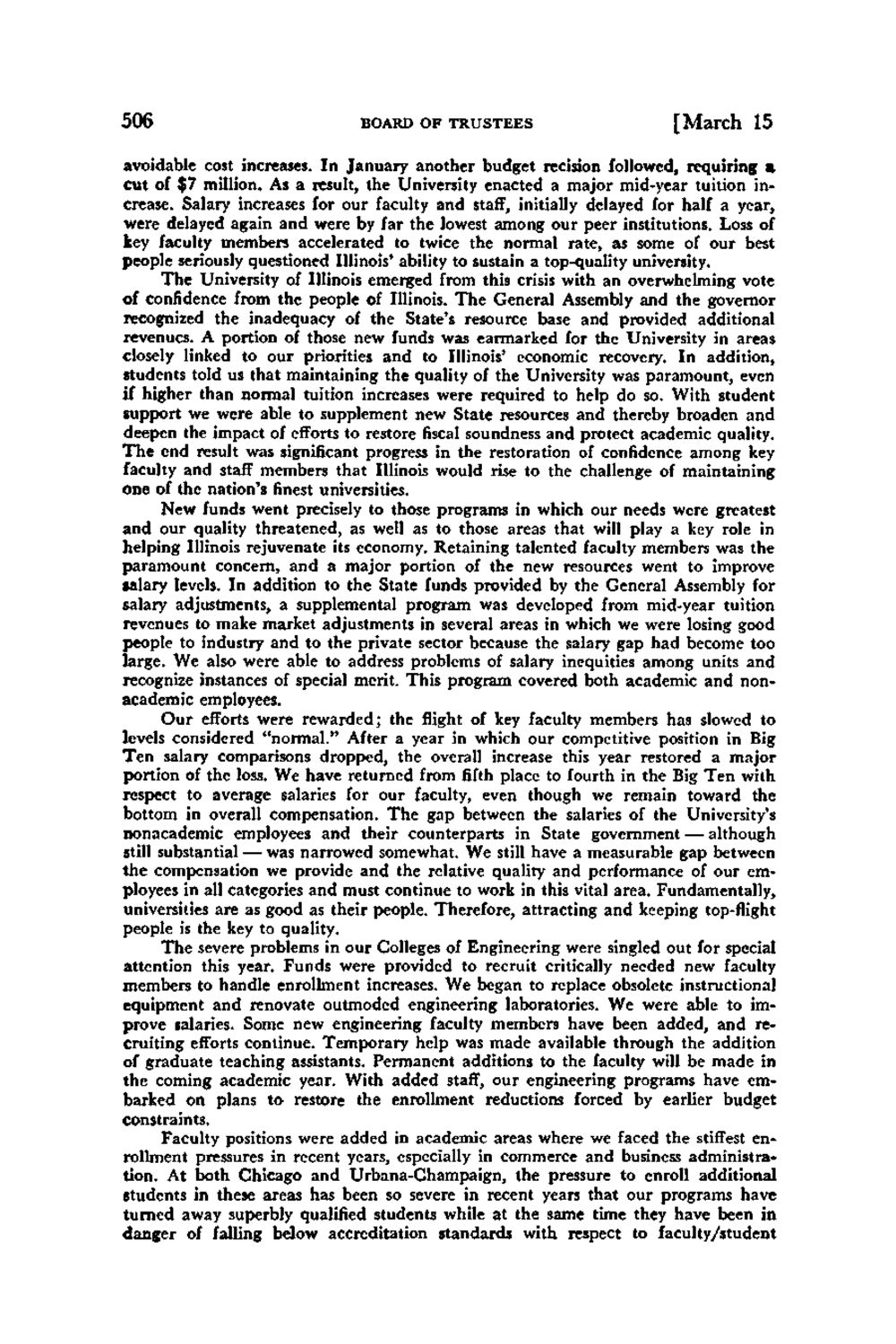| |
| |
Caption: Board of Trustees Minutes - 1984
This is a reduced-resolution page image for fast online browsing.

EXTRACTED TEXT FROM PAGE:
506 BOARD OF TRUSTEES [March 15 avoidable cost increases. In January another budget recision followed, requiring a cut of $7 million. As a result, the University enacted a major mid-year tuition increase. Salary increases for our faculty and staff, initially delayed for half a year, were delayed again and were by far the lowest among our peer institutions. Loss of key faculty members accelerated to twice the normal rate, as some of our best people seriously questioned Illinois' ability to sustain a top-quality university. T h e University of Illinois emerged from this crisis with an overwhelming vote of confidence from the people of Illinois. T h e General Assembly and the governor recognized the inadequacy of the State's resource base and provided additional revenues. A portion of those new funds was earmarked for the University in areas closely linked to our priorities and to Illinois' economic recovery. In addition, students told us that maintaining the quality of the University was paramount, even if higher than normal tuition increases were required to help do so. With student support we were able to supplement new State resources and thereby broaden and deepen the impact of efforts to restore fiscal soundness and protect academic quality. T h e end result was significant progress in the restoration of confidence among key faculty and staff members that Illinois would rise to the challenge of maintaining one of the nation's finest universities. New funds went precisely to those programs in which our needs were greatest and our quality threatened, as well as to those areas that will play a key role in helping Illinois rejuvenate its economy. Retaining talented faculty members was the paramount concern, and a major portion of the new resources went to improve salary levels. I n addition to the State funds provided by the General Assembly for salary adjustments, a supplemental program was developed from mid-year tuition revenues to make market adjustments in several areas in which we were losing good people to industry and to the private sector because the salary gap had become too large. We also were able to address problems of salary inequities among units and recognize instances of special merit. This program covered both academic and nonacademic employees. O u r efforts were rewarded; the flight of key faculty members has slowed to levels considered "normal." After a year in which our competitive position in Big Ten salary comparisons dropped, the overall increase this year restored a major portion of the loss. We have returned from fifth place to fourth in the Big Ten with respect to average salaries for our faculty, even though we remain toward the bottom in overall compensation. T h e gap between the salaries of the University's nonacademic employees and their counterparts in State government — although still substantial — was narrowed somewhat. We still have a measurable gap between the compensation we provide and the relative quality and performance of our employees in all categories and must continue to work in this vital area. Fundamentally, universities are as good as their people. Therefore, attracting and keeping top-flight people is the key to quality. T h e severe problems in our Colleges of Engineering were singled out for special attention this year. Funds were provided to recruit critically needed new faculty members to handle enrollment increases. We began to replace obsolete instructional equipment and renovate outmoded engineering laboratories. We were able to improve salaries. Some new engineering faculty members have been added, and recruiting efforts continue. Temporary help was made available through the addition of graduate teaching assistants. Permanent additions to the faculty will be made in the coming academic year. With added staff, our engineering programs have embarked on plans to restore the enrollment reductions forced by earlier budget constraints. Faculty positions were added in academic areas where we faced the stiffest enrollment pressures in recent years, especially in commerce and business administration. At both Chicago and Urbana-Champaign, the pressure to enroll additional students in these areas has been so severe in recent years that our programs have turned away superbly qualified students while at the same time they have been in danger of falling below accreditation standards with respect to faculty/student
| |